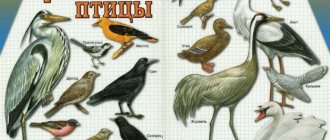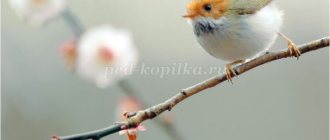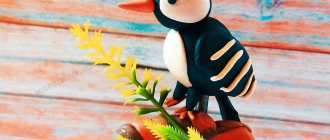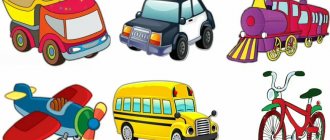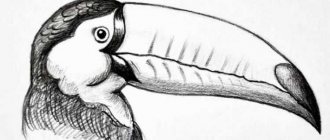Summary of a drawing lesson in the senior group “Birds of Migratory”
Summary of a drawing lesson in the senior group “Birds of Migratory”
Kind of activity:
direct educational
Age group:
senior group
Subject:
"Migratory birds"
Target
: consolidate methods for conveying bird proportions; develop creative imagination; cultivate a caring attitude towards the environment; consolidate and expand knowledge about wintering and migratory birds. We continue to develop fine motor skills; observe the sequential execution of the drawing; cultivate a love for birds.
Software tasks:
Educational:
- practice drawing birds;
- consolidate the methods of making a sketch with a simple pencil and then painting over it with watercolors;
Educational:
- develop the ability to analyze drawings;
-develop memory, thinking, fine motor skills of the hands, and the ability to enjoy the results of one’s work.
Educational:
— caring attitude towards birds and nature;
- to form in children the desire to complete the work they start.
Methods and techniques:
-Visual: looking at illustrations (paying attention to the characteristics of birds - size, color, leg length, beak shape).
-Verbal: conversation, explanation;
Preliminary work:
looking at illustrations of birds, viewing slides “Migratory Birds”.
Material and equipment:
pictures of birds; drawing paper, pencil, eraser, watercolor, brushes, water jar, palette.
Progress of educational activities:
Educator:
- Let's see what birds are sitting on our tree? Name them. (crow, magpie, woodpecker, tit, black grouse)
- Oh, guys, I can’t understand something, are all the birds gathered on the tree? Help me to understand. (Children find out that all birds winter and there are no migratory ones.)
- What happened? Where have the migratory birds gone? (children's answer)
- Guys, let's think, why are birds called migratory? That's right, migratory birds are birds that come to us in the spring, and in the fall they fly to warmer climes. Why do these birds fly away from us in the fall?
-All these birds eat insects. And in the fall the insects disappear. Birds are deprived of their main food and are forced to fly to warmer climes. There are many insects there all year round. Let's list the migratory birds (swallow, crane, stork, cuckoo, swan, starling, wagtail, duck, lark, heron)
- Please look at all of these and name their similarities and differences. (similarities are the body, head, tail, etc.; differences are the color of the plumage). You and I have already drawn a bird with a pencil. Today we will also draw with paints.
Physical exercise “A flock of birds is flying south”
A flock of birds flies south, the sky is blue all around. (Children wave their arms like wings) In order to fly faster, you need to flap your wings. (Children wave their hands more intensely) The sun is shining in a clear sky, An astronaut is flying in a rocket. (Stretching - arms up) And below the forest, fields - The earth is spread out. (Low bend forward, arms spread to the side)
The birds began to descend
Everyone sits down in the clearing.
They have a long way to go, the birds need to rest. (Children sit in a deep squat and sit for a few seconds) And again it’s time to hit the road. We have a lot of flying to do. (Children stand up and flap their “wings”)
Here comes the south. Hooray! Hooray! It's time for us to land. (Children sit at tables)
- Now look at these pictures. Let's name what parts a bird consists of? (head, body, tail, wings) What shape is the head? (round) What shape is the body? (oval) What shape is the tail? (can have a triangular shape, or can be forked, like a swallow) The wings have a curved shape if the bird is flying, and oval when folded. The beak is triangular.
— You know how to draw geometric shapes. Therefore, you can easily depict the components of birds. You just need to connect them correctly.
Practical part:
-First, let's draw an oval body. Then we will draw the head. Oval wings, slightly pointed at the ends - these are the longest feathers. Rectangular tail, triangular beak, round eyes. And then, let's draw the paws, draw the feathers.
— We take simple pencils and make sketches. (children draw). Then we will paint our bird with paints and create a background.
Result:
- Well done boys. You all did your best and we got wonderful birds.
— What migratory birds do we know?
-Well done guys, you did a very good job today. With each lesson your work gets better and better! Well done!
After class, the work is displayed in a corner along with the original pictures, so that other children can look and compare.
Notes on drawing in the senior group “Birds fly south”
Ekaterina Kleeva
Notes on drawing in the senior group “Birds fly south”
SUMMARY OF NODES ON DRAWING IN THE SENIOR GROUP
«BIRDS FLY SOUTH»
ART TEACHER: KLEEVA E. V.
PROGRAM CONTENT: teach children to sketch birds in motion , conveying the basic shape and main parts. Without drawing the details of the plumage . Practice sketching with one pencil or one paint. Consolidate and expand knowledge about wintering and migratory birds . Cultivate a caring attitude towards birds .
MATERIALS: Landscape sheets tinted with blue-violet color (autumn sky, simple pencils, wax crayons; illustrations depicting birds flying south ; reproduction of Stepanov’s painting “The Cranes Are Flying”
.
CONNECTION WITH OTHER EDUCATIONAL AREAS: Watching birds while walking , paying attention to their varied movements
Summary of drawing lesson “Bird on a branch” (senior group)
Natalia Voronina
Summary of drawing lesson “Bird on a branch” (senior group)
Notes on drawing "
Bird on a branch " (
senior group ) .
Notes on drawing "
Bird on a branch " (
senior group ) .
- expand and consolidate children’s generalized ideas about wintering and migratory birds, teach them to classify into wintering and migratory birds;
— to develop in children the ability to draw a bird , conveying the shape of body parts and beautiful plumage; practice drawing with wax pencils;
- teach children to make a sketch with a simple pencil;
-develop figurative perception, imagination;
- be able to convey your impressions and observations of birds drawing
Equipment and materials: A4 album sheets, wax pencils, simple pencils, an easel, three envelopes of different colors, pictures depicting migratory and wintering birds, a bird drawing .
Abstract of GCD for drawing “Birds of Migratory”
MARINA CHERNYAK
Abstract of GCD for drawing “Birds of Migratory”
GCD for drawing “ Birds of passage ”
with children 5-7 years old
teach children to sketch birds in motion , conveying the basic shape and main parts. Without drawing the details of the plumage . Practice sketching with one pencil or one paint. Consolidate and expand knowledge about wintering and migratory birds . Cultivate a caring attitude towards birds .
birds flying south ; reproduction of Stepanov’s painting “The Cranes Are Flying”
.
GCD move
1. Finger gymnastics
Visiting the thumb Put the thumbs of both hands up
Came straight to the house: Index and middle,
Nameless and last. Alternately, the called fingers are connected to the thumbs on both hands at the same time
The little finger itself Fingers are clenched into a fist, only the little fingers point upward
He knocked on the threshold. Fists knock on each other
Together fingers are friends,
They cannot live without each other. Rhythmic clenching of fingers into fists
- Guys, let's remember what time of year it is (Autumn)
.
Right. And what changes occur in nature with the arrival of autumn (Children list the signs of autumn ?
- Well done! Correct! But today I would like to talk about birds . Let's remember what birds we have seen and know (Children's answers)
.
Do they all stay with us for the winter (No? What are the names of those birds that are not afraid of the cold and stay here (Winterers? What wintering birds do you know (Sparrow, crow, tit, bullfinch, pigeon, owl, woodpecker, magpie?
And What are the names of birds that fly away to warm regions ( Migratory ? Yes. That’s right. What migratory birds do you know (ducks, swans, cranes, swallows, rooks, starlings, cuckoos? Why do you think they fly away (They are cold here and nothing to eat?
- Right. Birds that fly away . Many migratory birds eat insects . birds in search of food .
– Look carefully at the illustrations.
Pay attention to how the birds . Waders, herons, fly in a line , in front or in a transverse row. Geese most often fly in a school. Geese, cranes, swans and other large birds .
- Guys, let's rest a little. Imagine that you are birds and repeat after me:
Birds jump and fly. They wave their arms and jump up and down
Birds collect crumbs. "Peck"
The beaks were cleaned. Stroke your hands and noses
Birds fly, sing, wave their arms
The grains are pecked. "Peck"
4. Independent activities of children
– Have you rested? Fine! And now I suggest you draw birds flying south . Look what's on your tables (Children's answers? First we will make a sketch with a simple pencil, and then we will outline and color it with wax pencils.
During the practical part, explain to the children that sketches should be drawn with light lines ; they need not be finished, not finished to the end; you can leave the failed form and start another; I need to try to make more sketches. The resulting sketches are outlined with a wax pencil.
During the lesson, the teacher analyzes the images created by the children, explains mistakes, and guides them in searching for the correct representation of form and movement.
At the end of the work, the children attach the drawings to the board. Demonstration of their works by children; choose the most neat and beautiful works with the children.
– Children, what did we do today (Children’s answers)
Well done, you all tried your best and you did a good job. Thank you.
According to popular belief, where the stork makes a nest, happiness will settle. Maybe that’s why, or maybe also because the stork is a large and beautiful bird , but all people have a special relationship with the stork. Unfortunately, to draw a stork “from life,” so if you need a drawing of a stork in a nest, look for a suitable photo on the Internet.
To make it easier for you to draw a stork standing or sitting in a nest, let’s first draw a flying stork, step by step, with a simple pencil.
1. Where to start drawing a stork
2. Wings, beak and tail of a stork
The first, most important contours have been drawn , now it will be easy to draw a stork , as if assembling a construction set from Lego parts , gradually adding more and more details. First draw the general shape of the stork's beak. Then you can draw the tail and at the very end draw the first outlines of the wings.
GCD move
I. Finger gymnastics
Visiting the thumb Put the thumbs of both hands up
Came straight to the house: Index and middle,
Nameless and last. Alternately, the called fingers are connected to the thumbs on both hands at the same time
The little finger itself Fingers are clenched into a fist, only the little fingers point upward
He knocked on the threshold. Fists knock on each other
Together fingers are friends,
They cannot live without each other. Rhythmic clenching of fingers into fists
- Guys, let's remember what time of year it is (Autumn)
. Right. And what changes occur in nature with the arrival of autumn (Children list the signs of autumn?
- Well done! Right! But today I would like to talk about birds . Let's remember what birds we have seen and know (Children's answers)
.
Do they all stay with us for the winter (No? What are the names of those birds that are not afraid of the cold and stay here (Winterers? What wintering birds do you know (Sparrow, crow, tit, bullfinch, dove, owl, woodpecker, magpie?
